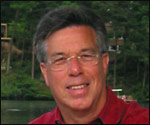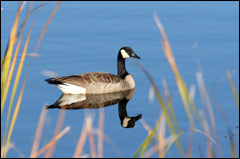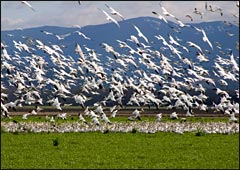
David Feld.
With what environmental organization are you affiliated?
I am the national program director of GeesePeace.
What does your organization do?
GeesePeace is an educational nonprofit organization that helps communities humanely resolve wildlife conflicts. Currently our specific focus is Branta canadensis — the Canada goose. Many communities in the U.S. have a growing problem with resident Canada geese that were born in the area and have no need to migrate. Canada geese born in Canada will migrate in the spring to nest in Canada and fly south in the winter.
What are you working on at the moment?
In March we have regional training meetings for GeesePeace communities. We have projects in Oyster Bay, N.Y., the New Jersey Shore, and Stratford-upon-Avon, U.K., to name a few. Our largest project is one covering an area of 60 miles around New York City. It covers areas as far north as Greenwich, Conn., and as far south as Spring Lake, N.J., and includes a good portion of New York’s Hudson Valley. We call this the 60 Mile Tri-State Regional Canada Geese Populations Stabilization Project.
The program in the U.K. is run by the Stratford Town Management Partnership. They will have a symposium next year in Stratford for other communities in the U.K., like Chesterfield, which has expressed an interest in starting a program.
How do you get to work?
Everyone in GeesePeace has a “virtual” office. We use technology to keep in touch and meet, eliminating the need to commute to a fixed office site and minimizing unnecessary work-related travel.
What long and winding road led you to your current position?
Actually, it was a very direct road. My community had a problem with Canada geese. Some people wanted to kill the geese, others did not. As a community leader, I chose to find a humane solution and committed to helping other communities do the same. I said, “We went to the moon — we can figure out how to solve a goose problem humanely and without controversy.” That is how GeesePeace began; now it is an organization with international reach and effectiveness.
Where were you born? Where do you live now?
I was born in Brooklyn, N.Y. Now I live in Lake Barcroft, Va.
What has been the worst moment in your professional life to date?
There has been no worst moment. Even when things do not work out as expected or there is a disappointment, there is always some good that is derived from the experience or the journey.
What’s been the best?
Making the decision to get GeesePeace under way, and then doing it.
What environmental offense has infuriated you the most?
Smoking in public places. With regard to geese, it’s how this problem started in the first place.

Goose on the loose.
Photo: iStockphoto
Millions of Canada geese used to migrate north in the early spring to the Hudson and James Bays to nest and have their young, then migrate south in the late fall. Along the way, the geese were hunted by commercial hunters for down feathers and for meat, and by recreational hunters for sport. To increase the “take,” or kill, the commercial hunters would bait fields with corn, capture migratory birds, and clip their feathers so the geese could not escape. Then the geese were placed as live decoys in lakes, sometimes with weights on their legs so they would stay put. Migrating flocks saw these geese, assumed everything was fine, flew in, and were blasted out of the air or on the water when they landed. Needless to say, this very efficient hunting practice was devastating to the migratory flocks of Canada geese.
Thus begins the story of one of the greatest cases of mismanagement by wildlife agencies (federal and state) in America. In 1965, a single flock of geese was discovered in Missouri after over-hunting drove them to near extinction. Wildlife agencies took these geese and encouraged them to nest all over the country by taking eggs, incubating them, and encouraging geese to double clutch (produce two nests). Unfortunately, migration is a learned process, so all of the geese that were born under this program did not know of Canada. They had no need to migrate, because the weather was temperate enough. So now we have Canada geese that do not migrate. These are the ones who are causing problems in communities. It’s not the geese’s fault. By nature they return to the place where they were born to build their own nests; then, in June, they molt (lose flight feathers) and are stuck in the area.
The geese problem in the U.K. began in the 1600s when King Charles II brought a few geese to England for his wildlife gardens.
Who is your environmental hero?
Holly Hazard, chief innovations officer of the Humane Society of the United States. She was previously the executive director of the Doris Day Animal League and is responsible for many programs that protect animals and improve their lives.
What’s your environmental vice?
I’m not yet a vegetarian.
How do you spend your free time (if you have any)?
I watch for ways to stimulate serendipitous events.
What’s your favorite meal?
Pasta and salad.
Which stereotype about environmentalists most fits you?
I do not litter.
What’s your favorite place or ecosystem?
Keukenhof tulip gardens in Lisse, Holland. There are 7 million tulips, arranged by thoughtful people.
If you could institute by fiat one environmental reform, what would it be?
Each year, I would ask each agency or department of every government to identify and implement at least one change in their operation or activities or institute a new idea that would lead to a cleaner, friendlier, or safer environment for all living things.
Who was your favorite musical artist when you were 18? How about now?
Then and now, Rolf Harris, singer of “Tie Me Kangaroo Down, Sport.”
What’s your favorite movie?
The Red Tent, a 1969 film about an expedition to the North Pole by Italian explorers.
Which actor would play you in the story of your life?
Joe Friday from Dragnet.
If you could have every InterActivist reader do one thing, what would it be?
The next time you see someone litter, pick up the paper or cigarette butt, catch up to the person, say, “I think you dropped this,” and return it to them.
Here in the temperate half of Oregon, there are millions of resident geese. They annoy or endanger farmers, golfers, airplanes, and others. How should those folks be thinking about their goose problem, now that it’s arrived? And what can they do that is both humane and effective to make the geese go away? — Charlie Weiss, Portland, Ore.

David Feld, GeesePeace.
Excellent question — this is a very common problem. In your temperate half of Oregon you have both resident and migratory Canada geese. My suggestion is to let them all be in the winter. During that time, just focus on keeping them away from areas where people are out and about. This is best accomplished by using a community border collie to flush the geese to other areas where no one cares. In the GeesePeace model program, the border collie has a home with a local family; volunteers or community staff take the collie from site to site to keep the geese moving, eventually arriving to a sanctuary or other refuge area. There are plenty of places geese can go where nobody cares. Eventually, the migratory geese will leave on their own. The resident geese will stay, and this is when you implement the complete GeesePeace program. There is more detail on the GeesePeace website.
Are “goose dogs,” trained to chase (but not catch) ducks and geese, a humane alternative? — Annette Dutro, Indianapolis, Ind.
The goose dog is a border collie, trained to herd on voice and hand command. Border collies should only be used when geese can fly. Using a dog against flightless geese and goslings is inhumane and ineffective. The best time to use a border collie is after the nesting season is over, about mid-May. Geese molt in mid-June and are flightless for six weeks, so getting them out before they molt is very important.
A border collie will flush the geese from land to a nearby water body and can continue flushing the geese with the assistance of a boat or kayak from the water. The border collie should be in the boat or kayak when this is being done. The geese then believe that the collie can reach them both on land and in the water, so they will eventually abandon the site for a safer, more secure location to molt.
What do you say to people who claim that when geese are harassed out of one area into another, they simply become a problem for someone else? — Sharon Pawlak, Medford, N.J.
I say to them, “You’re asking the wrong question.” And I hear this one a lot. Introducing a border collie to harass geese is actually changing the environment. It makes it a place where the geese don’t want to stay or feel safe. There are other ways to change the environment at the site, like draining a pond or building a high-rise. Using a border collie to flush the geese has the same effect, but is more environmentally friendly. Also, there are plenty of places geese can go where they do not cause conflicts with people and recreational facilities.
I’ve heard that goose poop is “poison” and somehow defiles our drinking water. What’s the story here? — Lee Wallace, Greensboro, N.C.
Goose poop is just digested grass. If there are poisons or dangerous bacteria in the environment and the geese eat it, it will likely show up in the poop. Getting rid of the geese does not change the fact that the poisons were in the environment in the first place.
What are local and federal wildlife agencies doing now that this problem has been put in the spotlight? Also, what is the status of the traditional migratory goose population? — M.G., Denver, Colo.
The U.S. Fish and Wildlife Service has recently passed new regulations [PDF] for managing resident Canada goose populations. The migratory goose population is still recovering.
Some of my earliest and fondest childhood memories involve feeding the ducks and geese at a local park. I know that’s an ecological no-no, but I think it helped form the foundation of a lifelong love of the natural world and concern for the environment. I’m curious about your suggestions for good alternative ways to engage little ones in a similar connection with nature and wildlife but without the baggage. — Christy H., Seattle, Wash.
I’m glad you asked this question. First, thank you for not feeding wildlife. Feeding bread and corn to Canada geese and other waterfowl is like feeding Twinkies to your children — they will eat it, but a steady diet of it will not be very nutritious. A high-protein diet of corn and bread causes angle wing in young geese. This is a deformity brought on by the feathers growing too fast for the developing bone structure to support.
So what is an alternative way to enjoy the wildlife? How about getting up early in the morning near a lake to watch the geese fly in a V formation, put out their wings in a long glide, and gently land in unison on the water? I’m from the city, where wildlife is a treat. The more I learn about wildlife and their habits and behavior, the more I appreciate them. It is fascinating. For example, if one looks at the pyramids of Egypt, they see pyramids and look in awe at the marvelous accomplishment. On the other hand, if one first studies the pyramids, the construction practices available at that time, and the history, seeing the pyramids takes on an even greater level of appreciation of the accomplishment and its meaning.
Recently I moved near a park with a lake that’s home to hundreds of geese. Is there a way to somehow make the flock smaller without having an urban goose hunt? — Rebecca English, Denver, Colo.

Get the flock out of here.
Photo: iStockphoto
Implement a Canada goose population stabilization program using the protocol developed by the Humane Society of the United States. This will mean no goslings or just a few goslings. Without goslings the adult geese have no biological need to stay at the site and can be encouraged to fly elsewhere to molt. Check with your state wildlife agency on registration and permit requirements, or see the U.S. Fish and Wildlife website for Resident Canada Goose Registration. A border collie is the best way to get geese without goslings to leave the area before the geese molt. Once they are gone you will have a goose-conflict-free environment for the spring, summer, and fall.
We heard that Kool-Aid was an effective solution for goose control but was not currently approved by the FDA for that purpose. Can you tell us anything about that? — Gale T., Huntington Station, N.Y.
Kool-Aid will not work. You are probably referring to a liquid repellent that smells like grape juice. Repellents like this have only site-specific application. They will only work for a short period of time. They wash off in the rain and must be reapplied after cutting grass. After a while the geese will continue to eat the grass.
Canada geese nest in the landscaping of the parking lots near my work. I always hear coworkers complaining that a goose “went after them” as they were coming in to our building. Do you have any tips for how to keep a goose from chasing a person into a building? — Annette Dutro, Indianapolis, Ind.
When a goose is nesting close to an entrance or walking path, the gander will defend the nest from anyone who approaches too closely. First try fencing off the nest, leaving an opening for the mother goose and gander to walk in and out. Storm fencing is a good choice. Leave plenty of room around the nest. If that does not work, have a skilled person take down the nest. The goose will rebuild elsewhere. You must register with the U.S. Fish and Wildlife Service to destroy a nest, and state regulations may be more restrictive.
Are Canada geese a federally protected bird in Alabama? I have a friend who says they hunt them almost all year round down south. — Randy Mize, Birmingham, Ala.
The U.S. Fish and Wildlife Service have regulations that limit hunting to only certain times during the year. States may have other limits, but must be more restrictive, not more liberal.
Can you play the didgeridoo? — Merrilee Cichy, Little Falls, N.J.
I play the wobble board.


